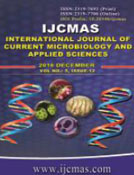


 National Academy of Agricultural Sciences (NAAS)
National Academy of Agricultural Sciences (NAAS)

|
PRINT ISSN : 2319-7692
Online ISSN : 2319-7706 Issues : 12 per year Publisher : Excellent Publishers Email : editorijcmas@gmail.com / submit@ijcmas.com Editor-in-chief: Dr.M.Prakash Index Copernicus ICV 2018: 95.39 NAAS RATING 2020: 5.38 |
The plastic pots experiment carried out during the months of the seventh and eighth of the year 2016 in order to study the effect of overlap between biogenic resistance and magnetic water to improve the qualities of sorghum plant growth and resistance to fungal pathogens of injury rate by F. graminiarum and R. solani. Carried out in accordance with the experience of pots full of random design C.R.D. A global experiment with three replications for 45 days study included the use of two fungi T.hamatum and A. niger for the induction of plant resistance against the two fungi F. graminiarum and R. solani as well as compared to treatment without the use of any fungus. Secondary transactions also included the use of a magnetic field strongly 4000 gauss for magnetization of irrigation water and compare the results with plain water (tap water). The results of the experiment the lack of effect of water magnetized and fungus growth-promoting mentioned on seed germination, while there was a clear effect of the fungus T. hamatum in all the characteristics of the studied growth of (healthy seedling, root length rate, average length of the shoot, wet and dry weight of the plant) as and the effect of fungus F. graminiarum since the beginning of the experiment as it led to the rot every plant seeds, while the results of mixing pathogenic fungi and stimulating growth under study noted that there is the effect of the dynamic of the fungus in the growth traits mentioned above. As for secondary treatment (magnetization irrigation water), there was a significant effect clear magnetization of water in the (safty seedling rate, the rate of root length, the length of the shoot rate, wet and dry weight of the plant), while the priority was to fungal bio-resistance and magnetized water to increase the qualities of plant growth studied.
 |
 |
 |
 |
 |